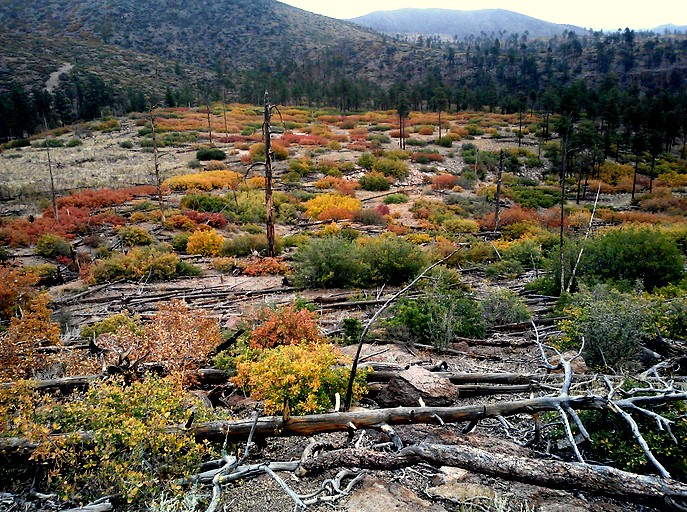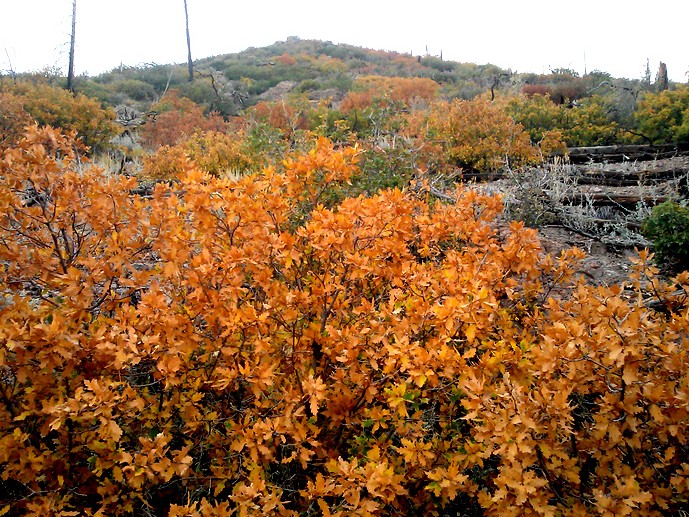I just took the pictures below in an area north of Los Alamos which was completely wiped out by fire 12 years ago. Prior to the fire, it was overgrown, sickly pine forest, caused by 70 years of fire suppression. Now it is full of life and color, thanks to the fire.
Disrupting the Borg is expensive and time consuming!
Google Search
-
Recent Posts
- Fact Checking The New York Times
- New Visitech Features
- Ice-Free Arctic By 2014
- Debt-Free US Treasury Forecast
- Analyzing Big City Crime (Part 2)
- Analyzing Big City Crime
- UK Migration Caused By Global Warming
- Climate Attribution In Greece
- “Brown: ’50 days to save world'”
- The Catastrophic Influence of Bovine Methane Emissions on Extraterrestrial Climate Patterns
- Posting On X
- Seventeen Years Of Fun
- The Importance Of Good Tools
- Temperature Shifts At Blue Hill, MA
- CO2²
- Time Of Observation Bias
- Climate Scamming For Profit
- Climate Scamming For Profit
- Back To The Future
- “records going back to 1961”
- Analyzing Rainfall At Asheville
- Historical Weather Analysis With Visitech
- “American Summers Are Starting to Feel Like Winter”
- Joker And Midnight Toker
- Cheering Crowds
Recent Comments
- Bob G on Fact Checking The New York Times
- Bob G on Fact Checking The New York Times
- Bob G on Fact Checking The New York Times
- arn on Fact Checking The New York Times
- conrad ziefle on Fact Checking The New York Times
- arn on Fact Checking The New York Times
- Bob G on Fact Checking The New York Times
- conrad ziefle on Fact Checking The New York Times
- Bob G on Fact Checking The New York Times
- czechlist on Fact Checking The New York Times





Nature’s wonder to behold.
Just let the fires burn. Why waste money and risk firefighters lives. Fire is a natural part of the life cycle in forests and on the prairie. People who build houses in areas susceptible to fire can pay higher ins premiums, or alternatively not use wood on the outside.
Smokey the Bear did us a great disservice in past decades.
Smokey bear was brilliant, and if the forest service had listened to him “prevent forest fires” the forests would be healthier. Smokey never said “fight fires” or “suppress fires” and there’s a big difference between prevention and suppression. but no, humans can’t handle the concept of fire as a natural part of a forest system, so we get into fire suppression which leads to high fuel burdens and overgrowth and eventually a mega fire (which is not good for a forest). So you see, Smokey had it right. As a side note; I live near and hunt in the very forest where Smokey found during the “Capitan Gap” fire.
-NMsnoman
Bears don’t talk
in spite of what the Ad Council would have us believe, the earliest references to Smokey, 1954, read “Smokey the Bear”, not “Smokey Bear”.
http://goo.gl/YcAjt
The current disinformation reminds me of the autism speaks ads, where the odds of having a kid with autism go down by the month. 1 in 160, no make that 1 in 150, no make that 1 in 121, no make that 1 in 88!
Makes me miss the wide open spaces…not to mention the vivid colors.
I live next to Yellowstone National Park. It is interesting that during the estensive1988 Yellowstone fires it was conservatives that were crowing the most about the ‘ecological disaster’, the ‘destruction’ of the ecosystem, the waste of timber, the foolhardiness of the let-burn policy, and how the park will never be the same. It was liberals and academics that were saying that fires are part of a natural process, a cycle, a renewal of the ecosystem. Boy how times have changed.
Ockham, the conservatives were saying that it was a waste of resources to not go in and thin the overgrown, fire-suppressed forests mechanically (Read: Logging), in order to try and prevent the uncontrollable, incredibly intense stand replacement fires. The reason that Smokey Bear was so successful for 50+ years was that overwhelming consensus of government experts, along with a complicit media, were able to bullshit the public into believing that their “science” of suppressing fires was rock-solid. Now where have we seen this kind of collusion between “government experts” and the media to push an agenda to “Save The Planet!”?
You are right about one thing … at the time, logging was seen as a panacea that could save the environment from the ravages of forest fires and it was pushed by conservatives. National parks, of course, were and still are, off limits to logging, much to their discontent. They made damned sure that we all new they told us the YNP fire was inevitable and the end of the park as we know it.
Allow me one correction to your thesis – it was an overwhelming collusion of government and industry experts along with a complicit media that promoted the benefits of logging and fire-suppression science (on National Forests). The hippies hadn’t completely infested government yet.
Fire IS inevitable in every forest— It’s the steps that are taken to mitigate the severity of those inevitable fires that matter. I’ve never found any quote attributed to a conservative that stated that logging was, in your words, a “panacea”. It’s simply one of the tools used to mitigate the intensity and/or severity of the inevitable fires. (There’s a difference in “intensity” and “severity” in wildland fire.) There is no single magic “silver bullet” to forest management, but putting all federal forests off-limits to thinning/logging operations will GUARANTEE that wildfires are bigger, hotter and more devastating. The flora and fauna bear the brunt of the misguided mismanagement of our nation’s national forests and we are all poorer for having our government’s policies being made by willfully ignorant political hacks under the spell of eco-nuts.
The link below is to an interesting piece of propaganda from the “experts” from many decades ago. (PDF warning!) Note how condescending the “experts” are to the non-scientists who questioned their “authority” and “consensus”.
http://www.wildfirelessons.net/documents/Shea_1940_pappies_burned_woods.pdf
Something not mentioned here: There’s a reason why pine sap is flammable (mariners made turpentine out of it). It’s flammable to facilitate fires and make them burn hotter. All pine forests have dry seasons in the warmer part of the year, precisely the time of year when dampness or postitively wet soil would ordinarily facilitate rot from micro- and macro- organisms that could break down the wood. To recycle the wood into its constituent elements and make those elements available for new growth, you need fire in a forest with a pronounced dry season.
I once backpacked across one of the Utah High Plateaus. Some of this was cross-country through aspen woods that hadn’t burned in 60 years. On one stretch I followed a fence line showing on the topo map. It had aspen trunks six inches in diameter piled across each other like jackstraws, three and four deep. Quite a climb. The Forest Service built a 20-mile road up to the top to encourage people to cut wood. Professional firewood cutters were exempt from permits. The F.S. was trying to clear as much wood as they could before the inevitable fire.
I wonder how many moronic alarmists actually join the volunteer fire fighters? Or do they just whine away to weak politicians to prevent normal people cutting timber, clearing timber, burning timber or using it to build furniture or a home?
I wonder what Bastrop State Park aka Lost Pine Forest looks like now. Nearly all of the pines got burnt last year.
http://www.statesman.com/news/news/local/lost-pines-forest-in-bastrop-state-park-is-threate/nRqQF/